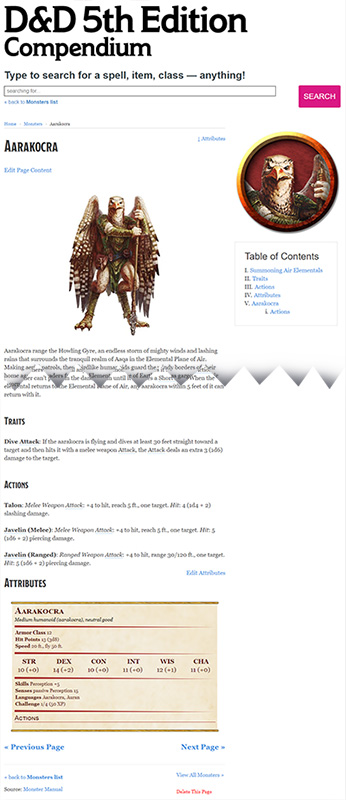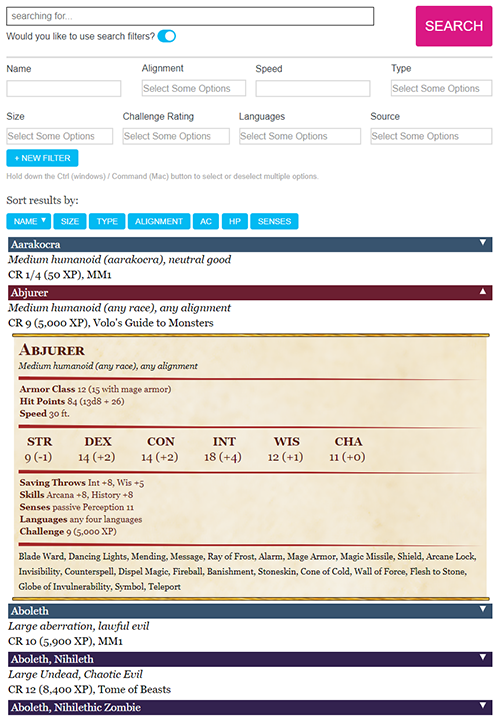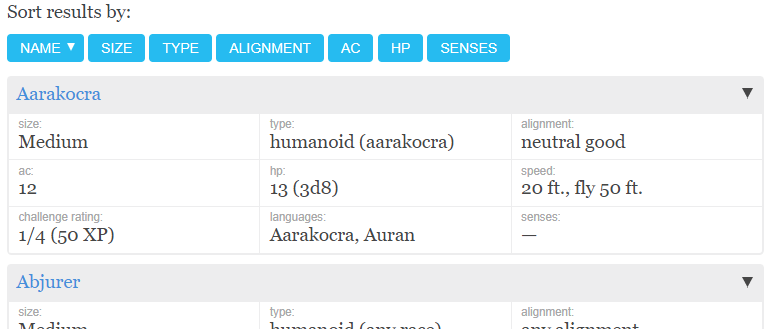External Compendium
From Roll20 Wiki
Page Updated: 2022-02-01 |
Main Page: Compendium

You can access the available External Compendiums by going to the website's main navigation bar and selecting Tools -> Compendium. This brings you to the Compendium Page where you can choose the Compendium you wish to browse.
Contents[hide] |
Available Compendiums
As of 2022-02-01, Roll20 have compendiums for 18 different game systems, accessible from roll20.net/compendium. Links to to a few:
Browsing a Compendium
Once you've selected a Compendium to browse, you'll first have a search bar available followed with an index of categories. Depending on the game ruleset in question, the available categories may be different, but what you will likely see are ones such as: Rules, Races, Classes, Items, Equipment, Spells, and Monsters. Underneath these categories are subpages and in some instances those subpages may be broken down into even further subpages. For instance, in the D&D 5th Edition SRD Compendium, the Spells category has subpages for each Class and each one of these pages is a list of spells which have their own dedicated page.
No matter which page of a Compendium you're on, there is a search bar directly above that allows you to look up for more entries at any time. The search looks for keywords used in the page title and header tags of an entry.
"Why isn't there an entry for (Spell, Rule, Monster, Etc.) in here?"
While it is possible that a Compendium could be missing content, especially in the case of newly built Compendiums, it's important to note that an OGL version of a rule system may not cover the entirety of the published rule system it's based from. For instance, the D&D 5th Edition OGL SRD does NOT have entries on Displacer Beasts or Mind Flayers, nor do they cover any other feats beyond Grappler. That is because they were purposely not included in the SRD (System Reference Document) when the publisher designed it. If something is missing from a Compendium, you should first check to see if that entry is actually part of the OGL SRD. If something is missing, contact the volunteers of that Compendium via the Character Sheets & Compendium forum.
Purchasing Compendium Expansions
Available on the Roll20 Marketplace are various Compendium Expansions. A purchase of one or more expansions grants access to entries that are not included in the original SRD ("Player's Handbook," Volo's Guide to Monsters and Tome of Beasts are examples of purchasable Compendium Expansions).
To access this content, all you need to do is purchase the expansion of your choice. Once bought, all content under that expansion becomes immediately available to you. It's important to note that access to these expansions' content shared in games is limited, and game owners must choose to share their purchased compendium content on a per game basis. Even without sharing, a GM can create handout and character journal entries of Compendium content by dragging entries to the Tabletop to generate them. These journal entries can then be shared among players on an as-needed basis if they themselves do not have access to the expansion content.
Compendium Search Filters
List pages on the Compendium feature special Search Filters for certain compendium categories. These filters allow you to filter through the entries dynamically via Compendium attributes without having to use the Compendium's Search Bar. Examples of such can be seen on the Spells List and Monsters List pages of the 5E SRD Compendium. The filtered list of entries are displayed underneath the search filters.
Utilizing the Search Filters
The Monsters List of the 5E Compendium has search filters for monster Name, Alignment, Speed, Type, Size, Challenge Rating, and Language.
The Spells List of the 5E Compendium has search filters for spell Name, Level, Class, School, Ritual, Concentration, Casting Time, Range, Spell Attack, Damage Type, and Save.
With the exception of the Name field and the monster Speed field (which are simple text fields), the rest of these hard-coded search filters are either drop down multi-select fields or Yes/No radio buttons. When selecting one of the multi-select fields, you will have every option that's available for that listed attribute. For example, the Spell List filter for spell School has the available selection options: Abjuration, Conjuration, Divination, Enchantment, Evocation, Illusion, Necromancy, Transmutation, or Evocation. You can choose multiple options from a select search filter. Hold down Ctrl(Windows)/⌘(Mac) while clicking on a search filter to choose multiple options from the select drop down list. You can also add more options afterwards, by clicking on the empty space to the right of the last filter item within the input field to bring up the selection drop down menu again.
Creating Your Own Search Filters
Each list page has a hard-coded set of search filters; however, you can create additional filters if you can't find what you need there. Below the preset filters is a blue button labeled + New Filter. Clicking on this will create a new filter field that offers a drop down select to choose an attribute to search by and then a text field underneath that to enter what you're searching for. Every single attribute used in the Compendium is available from this filter drop down menu. For instance, say you wanted to find all monsters that wear scale mail. You would create a new filter for the AC attribute on the Monsters List page and then enter the keyword "scale" into the provided text field. The monster list would then be filtered down to all monsters that have the word "scale" listed under their AC attribute.You can delete a custom search filter at any time by clicking on the X icon to the right of the filter's text field. Also, custom filters do not persist after closing or refreshing the page.
Hiding the Filters
Right below the Compendium search bar is a toggle button labeled Would you like to use search filters?. Clicking on the toggle icon will hide or reveal the search filter options (shaded blue when revealed, grey when hidden).
The Filtered Results
Below the Search Filters are the entries that get filtered and listed as tabled data. Each entry block begins with the entry's name that is also hyperlinked to its specific page within the Compendium. To save time, the tables display all of the attributes available from the search filter section and several more that would be helpful to have included here.Sorting the List
Entries displayed in the list are sorted in alphanumerical order, but you change which attribute to sort the list under. Under the text Sort results by: are blue buttons that list every attribute that is displayed in the list. Click on any of these buttons to sort via that attribute. You'll be able to tell which is currently selected when an up or down arrow appears beside the attribute's name within the button. The arrow's direction indicates whether the sort is ascending or descending in alphanumerical order. Clicking on the same button will toggle between an ascending or descending list order.
Entry Summaries
Initially hidden from view, each search result entry has a summary which displays the first couple sentences of the linked Compendium page which includes a secondary link to direct you to the entry's page to view the rest of its content. You can reveal an entry summary by clicking on the down arrow to the far right of the entry's name. Clicking on this arrow again will hide the summary section again.
Turning Compendium Pages
Compendium expansions have had their pages given a order to follow the sequence found in the physical book. At the bottom of a page in an expansion, there will be << Previous Page and Next Page >> links. These will bring you to the previous or following page in the order so you can read the compendium content in a similar fashion as a book. If you mouse over the Previous and Next links, the hover text will display the title of the page you will be navigating to.
Related pages
- i Compendium (how to use it inside a game)
- Compendium Sharing














